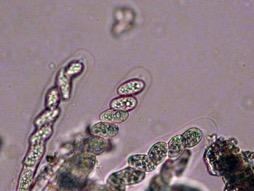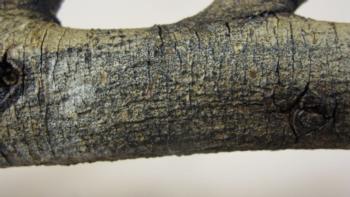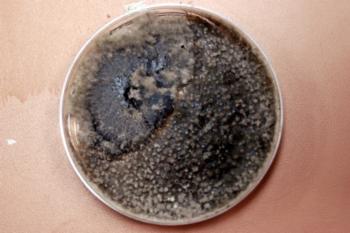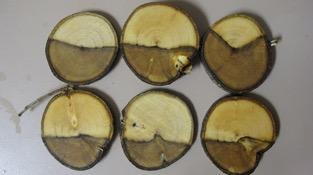DISEASE FOCUS: The rise of Bot canker diseases
by Jim Downer
Botryosphaeria is a genus of fungi that causes diseases of woody plants commonly known in California as “Bot canker.” Although these plant problems are considered canker diseases, they can also be blight-like when small twigs are involved in heavy infections. Typically Bot canker is stress related, and becomes especially damaging during periods of extreme water stress or drought (Brooks and Ferrin 1994).
Landscapes, native plant communities and orchards are alive with Botryosphaeria infections due to California’s fifth year of extreme drought. Bot canker has also been an increasing problem in nurseries, as I described in my regional report in the UCNFA News Spring 2015 issue. Although the effects of drought stress in production areas are more subtle than in unirrigated nonproduction areas, irrigation water quality is deteriorating in the western United States as the drought worsens, and this saltier water imposes osmotic stress on root systems. This further predisposes woody plants in nursery production to “Bot fungi.” Many news sources have indicated that El Niño will not solve our drought, and there is also evidence that drought effects on vegetation have “legacy” effects. This means that trees suffering drought in Mediterranean ecosystems, surrounding many nursery production areas, do not recover for 2 to 4 years after drought has passed (Anderegg and others 2015). Thus, we can expect Botryosphaeria inoculum to continue to plague nurseries for several years post El Niño.
Bot Biology
Botryosphaeria is in the class Ascomycetes because it produces ascospores (fig. 1) in an ascus contained in a perithecium usually found within a fruiting body or ascocarp (pseudothecium). These fruiting bodies are easily seen with a hand lens at 10x or with the unmagnified eye. Botryosphaeria fungi also frequently produce asexual spores in a very similar looking structure called a pycnidium. Spore-containing structures (perithecia or pycnidia) look like small black dots and are usually found in dead tissue.

Fig. 1. Ascospores of Botryosphaeria causing Ficus canker disease. Photo: A J Downer.
Identification of the contents of the fruiting bodies at 100x magnification assists in identification of species. Since it was not known (before the advent of modern molecular tools) what the perfect stage of pycnidium-forming fungi were, these fungi were typically given genus names in the class of asexual fungi known as Coelomycetes (imperfect fungi that form asexual spores within a fruiting body). This caused Bot fungi to have many different genus names beyond the perfect stage name (Botryosphaeria), such as Fussicoccum, Neofussicoccum and Dothiorella. Since Bot fungi seemed unique to certain hosts, many species names were described over the years for both perfect and imperfect stages of these fungi.
While many Bot species are in the literature, B. dothidea is perhaps the most common in landscapes, nurseries and orchards, having been recovered from over 35 hosts (Michailides and others 2000, Zhonghua and others 2001). It has a very wide host range, and can survive on an amazing array of host plants. While B. dothidea is mostly asexual on plants such as pistachio, it forms both the sexual and asexual stages on commonly grown ornamental plants such as redwood.
Sometimes several Botryosphaeria species cause disease in a single host at the same time (Mayorquin and others 2012). Spores are splashed to new branches with rain or overhead irrigation. There is some evidence that insects and even birds may also vector spores of Bot fungi.
Symptoms and Signs
Bot fungi kill phloem tissue, eventually girdling branches and twigs. Affected nursery stock may have symptoms of leaf drop (defoliation), yellowed foliage, wilt, or increased deadwood. Dieback occurs on all ages of woody growth from young tips to entire branches and even the main stem of some woody plants. After the branch dies, sexual and asexual stages may form in dead branch tissue. However, close examination of affected branches will not often reveal the fruiting bodies, which are illustrated in fig. 2. This is because of two factors: (1) signs of Bot fungi only form on dead tissues, so symptomatic branches may just not have formed fruiting bodies yet; and (2) since fruiting bodies are small they are often covered in dirt or dust and easily overlooked.

Fig. 2. Fruiting bodies of Botryosphaeria spp. on Ficus microcarpa. Fruiting bodies are only found on dead branches and may not be easily seen. Photo: A J Downer.
Management
Diagnosis of Botryosphaeria involves detection of disease symptoms and signs and may involve isolation of the pathogen on media for confirmation (fig. 3). It is helpful to wash cankered branches and twigs to make observation of fruiting bodies easier. When branches or twigs are cut from a Botryosphaeria infected plant, they often show a typically discolored xylem tissue (fig. 4). Bot fungi also stain media very dark when they are cultured on potato dextrose agar.

Fig. 3. Botryosphaeria isolates fruiting in the media with pycnidia. Note the dark color of the culture. Photo: A J Downer.

Fig. 4. Discolored wood of Ficus microcarpa infected with Botryosphaeria spp. Photo: A J Downer.
Nursery growers with deteriorating water quality who can implement practices to reduce salinity (e.g., blending water, using RO water, leaching), will reduce osmotic stress on root systems and the predisposition of woody plants to Bot fungi. It also becomes more imperative during drought conditions to monitor irrigations so that container stock does not dry out. Removal of cankered branches or disposal of heavily infected plants as soon as they are detected is a prudent inoculum reduction practice. For more treatment recommendations and additional photos, see the UCNFA News Spring 2015 issue.
Jim Downer is Environmental Hort Farm Advisor, UC Cooperative Extension, Ventura County.
References
Anderegg WRL, Schwalm C, Biondi F, Camarero JJ, Koch G, Litvak M, Ogle K, Shaw JD, Shevliakova E, Willliams AP, Wolf A, Ziaco E, Pacala S. 2015. Pervasisve drought legacies in forest ecosystems and their implications for carbon cycle models. Science 349:528-532.
Brooks FE, Ferrin DM. 1994. Branch dieback of southern California chaparral vegetation caused by Botryosphaeria dothidea. Phytopathology 84:78-83.
Downer J. 2015. Regional report: Bot fungi wreak havoc during drought. UCNFA News 19(1): 20-21.
http://ucanr.edu/sites/UCNFAnews/Regional_Report_Ventura_and_Santa_Barbara_Counties/Spring_2015__Bot_fungi_/.
Mayorquin JS, Eskalen A, Downer AJ, Hodel DR, Liu A. 2012. First report of multiple species of the botryosphaeriaceae causing bot canker disease of Indian laurel leaf fig in California. Plant Disease 96: (3) 459.
Michailides TJ, Morgan DP, Felts D. 2000. Other hosts of Botryosphaeria dothidea and their relation to pistachio Botryosphaeria blight. In Calif. Pistachio Ind. Annu. Rep. 1999-2000. Phytopathology 83:145-152.
Zhonghua M, Boehm EWA, Luo Y, Michailides TJ. 2001. Population structure of Botryosphaeria dothidea from Pistachio and other hosts in California. Phytopathology 91:665-672.












